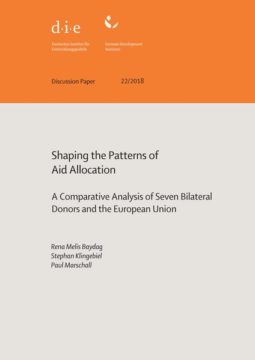Partner country selection is one of the key elements of development policy. It lies at the centre of the development policy decision-making of donor countries and institutions, and plays a significant role in shaping the patterns of official development assistance (ODA) allocation. The existing literature on ODA allocation has either a focus on how it should be (normatively) organised, on which determinants are (ex post) responsible for aid flows by using regression analysis looking for causal relationships, or stands somewhere between them. We argue that there is a gap in the literature in terms of analysing whether the actual flows of ODA reflect donors’ stated intentions in partner country selection. It is the aim of this paper to analyse the partner country selection approaches of selected members of the Development Assistance Committee (DAC) of the Organisation for Economic Co-operation and Development (OECD) during the last years, their principles in development policy-making and how their approach is reflected in the formulae applied. The European Union, France, Germany, Japan, the Netherlands, Sweden, the United Kingdom and the United States, which roughly share 70 per cent of the total ODA flows by all DAC donors, were chosen as case studies. In a descriptive analysis, we consider how aid allocation is organised by each donor, focusing on primary institutions/agencies, decision-making processes, and the principles/basic formulae applied in selecting partner countries. A map of the donors in terms of their intentions and allocation/actual flows is drawn. While principles are considered to shape intentions, interests and other confounding factors affect actual flows. In addition, the donors are compared by looking at three aspects of their approaches: firstly, whether donors are strategically-motivated (that is, whether they have security concerns, foreign policy and economic interests as the main motivation in their partner country selection) or follow development-oriented approaches (focusing on recipient-needs); secondly, whether they follow an explicitly stated agenda; and, thirdly, whether intentions are consistent with the actual ODA flows. Looking at these aspects, we suggest that 1) not every donor follows a clear approach in partner country selection; 2) actual ODA flows do not always reflect the stated intentions; and 3) most of the time, donors follow a mixture of development-oriented and strategic approaches.
- Veröffentlicht am Freitag 3. Mai 2024 von Deutsches Institut f. Entwicklungspolitik
- ISBN: 9783960210795
- 51 Seiten
- Genre: Gesellschaft, Politik, Sachbücher, Wirtschaft
